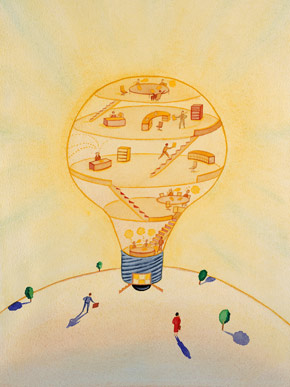Current research on neuroplasticity and adult learning suggests adults are more malleable than we might previously have believed and given the right conditions, we can rewire our brains. By Kate Kearins.
Changing up an attitude or swapping out a behaviour is something we are much more likely to expect of children rather than adults. You can’t teach an old dog new tricks, and leopards can’t change their spots, right?
Think again. Current research on neuroplasticity and adult learning suggests adults are more malleable than we might previously have believed.
In fact, given the right conditions, we can rewire our brains.
It’s important to note that the process of changing our habitual thinking is not for the faint-hearted.
In order to achieve it, we must want to make the change – and understand that it takes quite some effort to do so. After all, if it were easy, we would likely have attacked the problem, made the change and not even thought twice about it.
I recently took part in a mindset coaching programme with Leanne Holdsworth, director of the Sustainable Leadership Collective. As participants, we were each invited to identify and work on ‘One Big Thing’ that we wanted to change about ourselves. The programme comprised three group meetings and a couple of individual coaching sessions.
Based on the work by Harvard psychologists Robert Kegan and Lisa Laskow Lahey, and specifically on their book Immunity to Change, the course took us through a deep, individualised understanding of why, despite seeking change, we may sabotage our own efforts to achieve it.
Kegan and Lahey write about why we, as adults, might absolutely want to do one thing but do another – sometimes, even the opposite. They examine why we have one foot on the accelerator and the other so firmly on the brake that we don’t see any change or movement within ourselves.
By way of example, Kegan and Lahey cite instances where doctors tell heart patients that they will literally die if they don’t change their habits. Despite the dire warnings, only about one in seven of those patients actually succeeds in making changes.
The authors conclude that on their own, desire and motivation are not enough to affect change.
This so-called immunity or resistance to change reflects how deeply ingrained our habitual behaviours and mindsets can be. Resistance to change can be so strong that we fight any perceived threat to the status quo – even when the status quo is uncomfortable or life-threatening.
Fundamentally, our immune systems are quite fine-tuned; competing assumptions and commitments that make sense to us on an instinctive level still have the power to hold us back.
So, how did the mindset coaching programme encourage us to overcome our immunity to change?
First, we mapped our personal immunity to change and reframed our desired change in a positive rather than punitive way.
We then identified the assumptions holding us back. Seeing these assumptions laid bare in the cool, clear light of day could be quite confronting. They are our blind spots, unconscious and hidden beliefs, which over time have become interwoven and solidified.
What I liked about the immunity to change methodology is that it fits much of the theory on adult learning: it is self-directed, practical, big on the why (and the why not), and deeply reflective about personal experience.
The approach prompts us to test the validity of our assumptions and to practise change in areas that are important to us and are worth investing in – particularly in the more challenging areas of self-improvement.
Choosing the one big thing that will make a difference to performance is key.
Keegan and Lahey’s book is worth reading. It offers examples from corporate and public organisational settings, but it is equally applicable to unlocking potential at the personal level.
Kate Kearins is Professor of Management and Pro Vice Chancellor and Dean of Business, Economics and Law at Auckland University of Technology.










